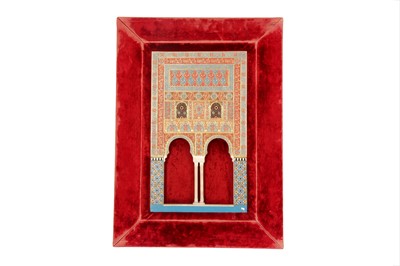16th Jul, 2021 14:00
Islamic & Indian Art
A LARGE AND IMPRESSIVE GILT AND POLYCHROME-PAINTED PLASTER RELIEF PLAQUE OF THE ALHAMBRA PALACE
Spain, mid to late 19th century
A LARGE AND IMPRESSIVE GILT AND POLYCHROME-PAINTED PLASTER RELIEF PLAQUE OF THE ALHAMBRA PALACE
Spain, mid to late 19th century
Of rectangular shape, carved, gilt and polychrome-painted, the relief replicating a Moorish architectural facade inspired by the Nasrid fortress and palace complex of the Alhambra in Granada, Andalusia, the architecture characterised by the typical repeating polylobed arches, polychrome star and geometric tiles on the lower wall panels, two arched windows with openwork lattice floral screens on the upper level, and the heavily decorated stucco walls enhanced with dense foliate arabesque patterns, split palmette trellis, dense knotwork and geometric designs, and repeating calligraphic roundels and rectangular bands with the Nasrid motto Wa La Ghaliba Illa-llah (there is no victory except God), the arches resting on a pair of alabaster columns, set within a wooden frame lined with madder red velvet cloth, the plaster relief 60.2cm x 32cm, 87.5cm x 64cm including the frame.
The Nasrid fortress and palace complex in Granada, Andalusia, known as the Alhambra, underwent a major restoration project between 1847 and 1889. Indeed, in 1847, Queen Isabella II appointed a team of restorers and specialists to preserve the facade and overall architecture from further decay. Rafael Contreras was nominated Head Restorer (adornista) of this project. His approach as a restorer only focused on the Alhambra’s wall surface, substituting original decorations with new plaster casts made in his workshop, using the re-discovered plaster technique of clay stamping (apretón de barro). Due to the substantial loss of the original plaster decoration, Contreras and his team deliberately decided to recreate all of the decorations on the walls, filling in any blank spaces, leading inevitably to the transformation of the original Nasrid complex into a new Alhambra, much more "Moorish" and Oriental in taste to meet the foreign visitors' expectations of the perfect exotic and picturesque stopover in their Romantic journey.
After realising the economic potential of creating souvenir plaster models to sell to visitors and with the Queen's enthusiastic approval and support, Contreras and his team of restorers started producing reduced scale models, usually 1:12, of the most important Islamic buildings in Spain. At first sight, his models seem faithful reproductions of specific walls or facades in the palace. However, the models were clearly based on and mirroring Contreras' restored panels, with wall decorations in an unblemished state to create a more complete vision of the palace. Thus, these architectural models are not exact copies of the original monuments, but rather the ideal archetype of the Orientalist Alhambra, so popular among European visitors and a romanticised attempt to boast Spain's glorious past (Asun González Pérez (2017), Reconstructing the Alhambra: Rafael Contreras
and Architectural Models of the Alhambra in the Nineteenth Century, Art in Translation, 9:1, 29-49, DOI: 10.1080/17561310.2017.1297041, http://dx.doi.org/10.1080/17561310.2017.1297041).
A number of similar panels have successfully been sold at auction through the years. For further reference, please see Christie's South Kensington 24 April 2012, lot 102; and 2 October 2012, lot 56; Sotheby's Paris, Pierre Berge: from One Home to Another, 30 - 31 October 2018, lot 772; and more recently, these Rooms, 2 December 2020, lot 800.
Dimensions: the plaster relief 60.2cm x 32cm, 87.5cm x 64cm including the frame
Sold for £1,000
Includes Buyer's Premium
Do you have an item similar to the item above? If so please click the link below to request a free online valuation through our website.



